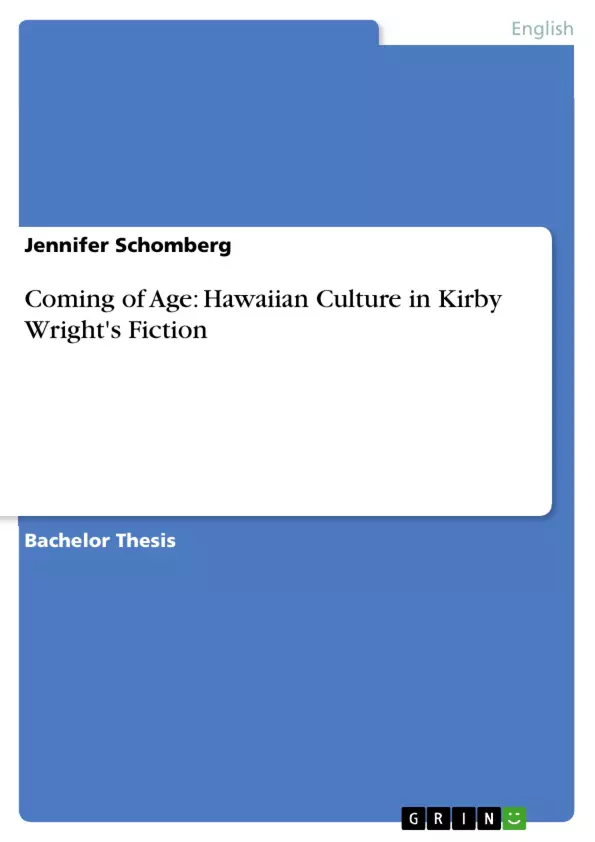Love and hate, joy and anger, passion and frustration, life and dreams, hopes and illusions – the themes and topics to be found in Kirby Wright’s fictional works is endless. A California resident with Hawaiian blood, growing up in Honolulu, HI, and attending Punahou School, a private school with such exquisite graduates like presidential candidate and governor Barack Obama, winning short story and poetry contests in his teenage years and then publishing two successful novels later on, Wright lived his dream coming out of a world that was caught in between cultures, which could not be any different. Experiences that directly translated into his works, with the protagonists Jeffrey and Ben Gill roaming the islands of Hawaii, always searching for a way to unite both worlds and free themselves of the stigma of being a hapa haole.
The present paper focusses on the fictional work of Kirby Wright, including the novels Punahou Blues and Molokai Nui Ahina, and explores the way Hawaiian culture and the topic of “coming-of-age” in a multicultural society are integrated and used. A brief introduction to Hawaiian literature and cultural history, including a portrait of author Kirby Wright, will be followed by a summary of both novels and a look into to what extent the setting of a novel is crucial to its interpretation, before I will then explore the way in which Wright presented the coming-of-age of the protagonist in his work and in how far this was connected to Hawaiian culture and traditions.
Inhaltsverzeichnis (Table of Contents)
- Introduction
- Hawai'i Literary History
- Literature and Ethnicity
- The origins of Hawaiian Literature
- Kirby Wright
- The Novels
- Punahou Blues
- Fiction and Autobiography
- Summary
- Molokai Nui Ahina
- Authentic Material
- Summary
- The importance of setting
- The setting of Punahou Blues
- Honolulu in 2008
- Re-Establishing the Kingdom
- The setting of Molokai Nui Ahina
- Brief History of Molokai
- Molokai in 2008
- The setting of Punahou Blues
- Punahou Blues
- Coming of Age in the Novels
- Definition of Coming-of-Age
- Coming-of-Age in Punahou Blues
- Family
- Manhood
- Love
- Coming-of-Age in Molokai Nui Ahina
- Family
- Love
- Identity
Zielsetzung und Themenschwerpunkte (Objectives and Key Themes)
This paper examines the fictional work of Kirby Wright, focusing on the novels *Punahou Blues* and *Molokai Nui Ahina*, exploring the integration and utilization of Hawaiian culture and the theme of "coming-of-age" in a multicultural society. The paper aims to analyze how Wright's novels depict the experiences of hapa haole protagonists navigating between cultures and seeking a sense of belonging.- The integration of Hawaiian culture into the novels
- The theme of "coming-of-age" in a multicultural society
- The depiction of hapa haole identity and experiences
- The significance of setting in shaping the narratives
- The exploration of family dynamics and interpersonal relationships
Zusammenfassung der Kapitel (Chapter Summaries)
The paper begins by providing a brief overview of Hawai'i's literary history, highlighting the influence of various ethnicities and cultural traditions on its diverse literary landscape. The chapter then explores the novels *Punahou Blues* and *Molokai Nui Ahina*, examining their narratives, characters, and themes. It analyzes how Wright utilizes setting and cultural details to create authentic and immersive experiences for readers. The paper then delves into the central theme of "coming-of-age" in Wright's novels, analyzing how the protagonists navigate their identities, relationships, and societal expectations in the context of Hawaiian culture.Schlüsselwörter (Keywords)
This paper explores the key concepts of Hawaiian culture, hapa haole identity, coming-of-age, multiculturalism, and the significance of setting in shaping narratives.- Quote paper
- Jennifer Schomberg (Author), 2008, Coming of Age: Hawaiian Culture in Kirby Wright's Fiction, Munich, GRIN Verlag, https://www.grin.com/document/158668



